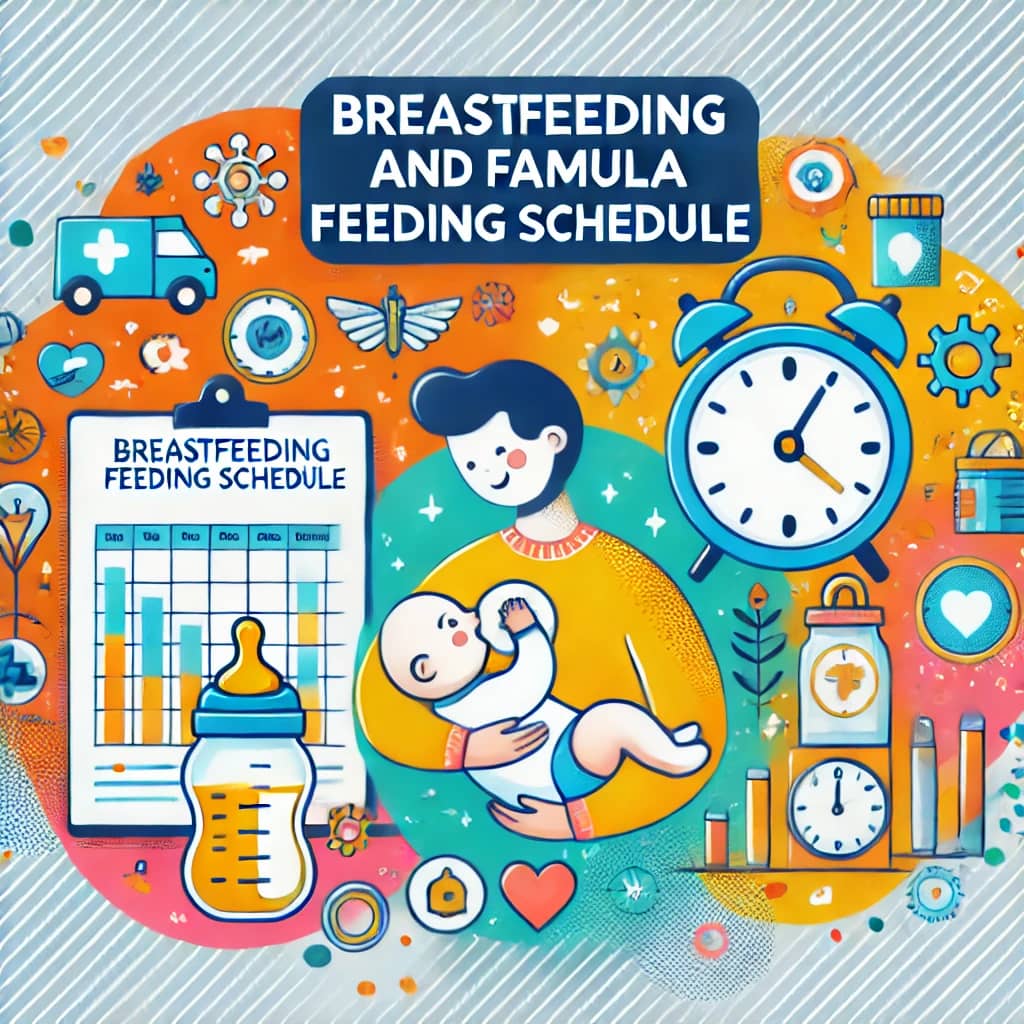
WEB-MOM – Feeding your baby is one of the most important aspects of early parenting. Whether you choose to breastfeed, formula feed, or use a combination of both, establishing a feeding schedule can help ensure your baby gets the nutrition they need. At Web-Mom.com, we aim to provide you with the information and guidance you need to create a feeding schedule that works for you and your baby.
“Discover essential tips for creating a breastfeeding and formula feeding schedule on Web-Mom.com. Learn how to balance feeding times, monitor your baby’s needs, and ensure proper nutrition.”
In this article, we will cover the basics of breastfeeding and formula feeding, how to establish a feeding schedule, tips for combining both methods, and common challenges with solutions.
Understanding Breastfeeding and Formula Feeding
Benefits of Breastfeeding
Breastfeeding offers numerous benefits for both baby and mother. Here’s why it’s recommended:
- Nutritional Superiority: Breast milk provides the perfect balance of nutrients and antibodies that support your baby’s growth and immune system.
- Bonding: Breastfeeding promotes bonding between mother and baby through close physical contact.
- Convenience: Breast milk is always available and at the right temperature, making it convenient for feeding.
Benefits of Formula Feeding
Formula feeding is a viable alternative or supplement to breastfeeding. Here’s why some parents choose formula:
- Flexibility: Formula feeding allows other caregivers to feed the baby, providing more flexibility for the mother.
- Monitoring Intake: It’s easier to measure and monitor the amount of milk your baby is consuming.
- Dietary Considerations: Formula feeding can be a good option for mothers who have dietary restrictions or medical conditions that affect breastfeeding.
Establishing a Breastfeeding Schedule
Newborns (0-3 Months)
Newborns have small stomachs and need to feed frequently. Here’s a typical breastfeeding schedule for newborns:
- Frequency: Breastfeed every 2-3 hours, or 8-12 times within a 24-hour period.
- Duration: Each feeding session may last 20-45 minutes.
- On-Demand Feeding: Feed your baby on demand, responding to their hunger cues such as rooting, sucking on their hands, or crying.
Infants (3-6 Months)
As your baby grows, their feeding patterns may change. Here’s a typical schedule for infants:
- Frequency: Breastfeed every 3-4 hours, or 7-9 times within a 24-hour period.
- Duration: Each feeding session may last 15-30 minutes.
- Night Feedings: Some babies may still need night feedings, but these may decrease as they approach 6 months.
Older Infants (6-12 Months)
Introducing solid foods will impact your baby’s breastfeeding schedule. Here’s what to expect:
- Frequency: Breastfeed every 4-5 hours, or 5-6 times within a 24-hour period.
- Duration: Each feeding session may last 10-20 minutes.
- Complementary Feeding: Continue breastfeeding while gradually introducing solid foods to meet your baby’s nutritional needs.
Establishing a Formula Feeding Schedule
Newborns (0-3 Months)
Newborns who are formula-fed will have similar feeding needs to breastfed babies. Here’s a typical schedule:
- Frequency: Feed every 3-4 hours, or 6-8 times within a 24-hour period.
- Amount: Start with 2-3 ounces (60-90 ml) of formula per feeding, gradually increasing as your baby grows.
- On-Demand Feeding: Pay attention to your baby’s hunger cues and adjust the schedule as needed.
Infants (3-6 Months)
As your baby grows, their formula feeding needs will change. Here’s a typical schedule for infants:
- Frequency: Feed every 4 hours, or 5-6 times within a 24-hour period.
- Amount: Increase to 4-6 ounces (120-180 ml) of formula per feeding.
- Night Feedings: Some babies may still need night feedings, but these may decrease over time.
Older Infants (6-12 Months)
Introducing solid foods will affect your baby’s formula feeding schedule. Here’s what to expect:
- Frequency: Feed every 4-5 hours, or 4-5 times within a 24-hour period.
- Amount: Offer 6-8 ounces (180-240 ml) of formula per feeding.
- Complementary Feeding: Continue formula feeding while introducing a variety of solid foods to ensure balanced nutrition.
Combining Breastfeeding and Formula Feeding
Benefits of Combination Feeding
Combination feeding can provide the best of both worlds. Here’s why some parents choose this approach:
- Flexibility: Allows other caregivers to help with feeding, giving the mother more flexibility and rest.
- Convenience: Provides options for feeding when breastfeeding is not possible or practical.
- Supplementation: Helps ensure your baby is getting enough nutrition if breastfeeding alone is insufficient.
Establishing a Combination Feeding Schedule
Combining breastfeeding and formula feeding requires careful planning. Here’s how to create a schedule:
- Alternate Feedings: Alternate between breastfeeding and formula feeding throughout the day. For example, breastfeed in the morning and at night, and offer formula during the day.
- Supplemental Feedings: Breastfeed on demand and offer formula as a supplement after breastfeeding sessions if your baby is still hungry.
- Adjust as Needed: Monitor your baby’s hunger cues and adjust the schedule as needed to ensure they are getting enough nutrition.
Tips for Successful Feeding
Monitor Your Baby’s Hunger Cues
Paying attention to your baby’s hunger cues can help ensure they are fed when they need it. Here’s what to look for:
- Early Cues: Rooting, sucking on hands, or smacking lips.
- Mid Cues: Fidgeting, fussing, or moving head side to side.
- Late Cues: Crying or becoming agitated (try to feed before reaching this stage).
Keep Track of Feedings
Keeping a feeding log can help you monitor your baby’s intake and identify any patterns. Here’s what to record:
- Time: Note the time of each feeding.
- Duration or Amount: Record the duration of breastfeeding sessions or the amount of formula consumed.
- Observations: Note any observations, such as your baby’s hunger cues or any signs of discomfort.
Ensure Proper Latch and Positioning
Proper latch and positioning are crucial for successful breastfeeding. Here’s what to do:
- Comfortable Position: Find a comfortable position for both you and your baby.
- Good Latch: Ensure your baby’s mouth covers a large portion of the areola, not just the nipple.
- Check for Signs: Listen for swallowing sounds and check for signs of a good latch, such as no pain and adequate milk transfer.
Common Challenges and Solutions
Engorgement
Breast engorgement can be painful and affect breastfeeding. Here’s how to manage it:
- Frequent Feeding: Feed your baby frequently to prevent engorgement.
- Cold Compresses: Apply cold compresses to reduce swelling and pain.
- Hand Expression: Use hand expression or a breast pump to relieve engorgement if your baby is not feeding well.
Nipple Pain
Nipple pain can be a common issue for breastfeeding mothers. Here’s how to alleviate it:
- Proper Latch: Ensure your baby has a proper latch to prevent nipple pain.
- Lanolin Cream: Apply lanolin cream to soothe sore nipples.
- Air Drying: Allow your nipples to air dry after feedings to promote healing.
Formula Intolerance
Some babies may have an intolerance to certain formulas. Here’s what to do:
- Consult Your Pediatrician: Consult your pediatrician if you suspect formula intolerance.
- Switch Formulas: Try switching to a hypoallergenic or lactose-free formula as recommended by your doctor.
- Monitor Symptoms: Monitor your baby for any signs of intolerance, such as fussiness, gas, or diarrhea.
Making Feeding Time Special
Bonding During Feeding
Feeding time is an excellent opportunity for bonding. Here’s how to make it special:
- Skin-to-Skin Contact: Practice skin-to-skin contact during breastfeeding or bottle feeding.
- Eye Contact: Maintain eye contact with your baby to strengthen your bond.
- Talk and Sing: Talk to or sing to your baby during feedings to create a calming and loving atmosphere.
Creating a Relaxing Environment
Creating a relaxing environment can make feeding time more enjoyable. Here’s what to do:
- Comfortable Seating: Choose a comfortable chair or rocker for feeding.
- Low Lighting: Use soft, low lighting to create a soothing atmosphere.
- Quiet Space: Find a quiet space free from distractions and noise.
Conclusion
Establishing a breastfeeding and formula feeding schedule is essential for ensuring your baby gets the nutrition they need. At Web-Mom.com, we hope this comprehensive guide provides you with the tips and strategies needed to create a feeding schedule that works for you and your baby.
By understanding the basics of breastfeeding and formula feeding, monitoring your baby’s needs, and addressing common challenges, you can ensure your baby’s feeding experience is positive and nurturing. Remember, every baby is unique, and it’s important to be flexible and responsive to your baby’s individual needs.
Thank you for visiting Web-Mom.com. We hope you find our articles helpful and inspiring as you navigate the joys and challenges of parenthood.

Web-Mom.com is a small blog, where you can find information to be a better parents. From parent to parents 🙂
Site Links
About Web-Mom
We always thinking, what will other parents do? How can they do it? So here we are, writing article from parents around the world. We know, you know.
Copyright 2024 web-mom.com


